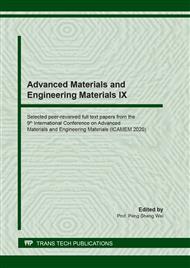[1]
H.Y. Li, P. Motamedi, J. D. Hogan, Characterization and mechanical testing on novel (γ + α2)- TiAl/Ti3Al/Al2O3 cermet, Mater. Sci. Eng. A. 750 (2019) 152-163.
DOI: 10.1016/j.msea.2019.02.039
Google Scholar
[2]
J.G. Song, Y. Liu, Ch.X. Wu, Fabrication and properties of Al2O3-Al cermet materials using different raw material composition parameter. J. Ceram. Process. Res. 21 (2020) 21-25.
DOI: 10.36410/jcpr.2020.21.1.21
Google Scholar
[3]
L.B. Zhao, N. Lin, Y.H. He, Improvement in microstructure and properties of Ti(C,N)-based cermets with Ruthenium additions, Ceram. Int. 44 (2018) 17553-17561.
DOI: 10.1016/j.ceramint.2018.06.156
Google Scholar
[4]
T. Gestrich, A. Kaiser, J. Potschke, J. Meinl, S. Hohn, Thermal behaviour of cermets and hardmetals during debinding and sintering, Int. J. Ref. Met. Hard Mater. 73 (2018) 210-214.
DOI: 10.1016/j.ijrmhm.2018.01.008
Google Scholar
[5]
X.H. Liu, M.L. Zhong, X.Y. Chen, Z.W. Zhao, Separating lithium and magnesium in brine by aluminum-based materials, Hydromet. 176 (2018) 73-77.
DOI: 10.1016/j.hydromet.2018.01.005
Google Scholar
[6]
Z.Y. Liu, K. Zhao, B.L. Xiao, W.G. Wang, Z.Y. Ma, Fabrication of CNT/Al composites with low damage to CNTs by a novel solution-assisted wet mixing combined with powder metallurgy processing, Mater. Design. 97 (2016) 424-430.
DOI: 10.1016/j.matdes.2016.02.121
Google Scholar
[7]
K.M. Chen, D.A. Tsai, H.C. Liao, I.G. Chen, W.S. Hwang, Investigation of Al-Cr alloy targets sintered by various powder metallurgy methods and their particle generation behaviors in sputtering process, J. Alloy. Compd. 663 (2016) 52-59.
DOI: 10.1016/j.jallcom.2015.11.231
Google Scholar
[8]
T. Liu, F.C. Li, A.D. Wang, L. Xie, Y. Yang, High performance Fe-based nanocrystalline alloys with excellent thermal stability, J. Alloy. Compd. 776 (2019) 606-613.
DOI: 10.1016/j.jallcom.2018.10.319
Google Scholar
[9]
Y. Lee, J. Jeon, S. Nam, T. Jang, H. Choi, Soft magnetic properties of Fe-based amorphous /nanocrystalline hybrid materials, Powder Tech. 339 (2018) 440-445.
DOI: 10.1016/j.powtec.2018.08.037
Google Scholar
[10]
B. Li, Z.G. Zheng, H.Y. Yu, D.C. Zeng, Improved permeability of Fe based amorphous magnetic powder cores by adding Permalloy, J.Magn. Magn. Mater. 438 (2017) 138-143.
DOI: 10.1016/j.jmmm.2017.04.082
Google Scholar
[11]
M.C. Rodríguez, A. Munoz, A.D. Rodríguez, Creep study on alumina and alumina/SWCNT nanocomposites, J. Eur. Ceram. Soc. 38 (2018) 5497-5502.
DOI: 10.1016/j.jeurceramsoc.2018.08.013
Google Scholar
[12]
S. Singh, R. Singh, Effect of process parameters on micro hardness of Al-Al2O3 composite prepared using an alternative reinforced pattern in fused deposition modelling assisted investment casting, Rob. Comp. Integ. Manuf. 37 (2016) 162-169.
DOI: 10.1016/j.rcim.2015.09.009
Google Scholar


